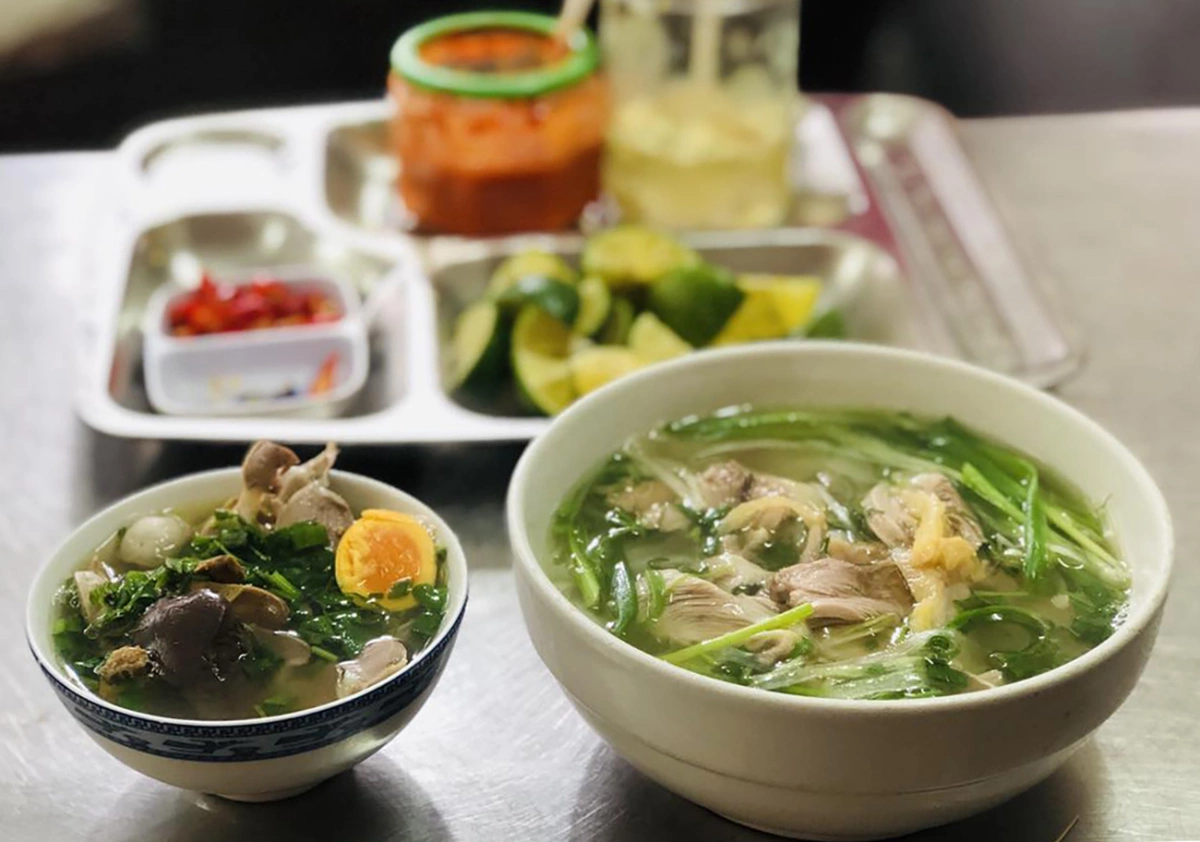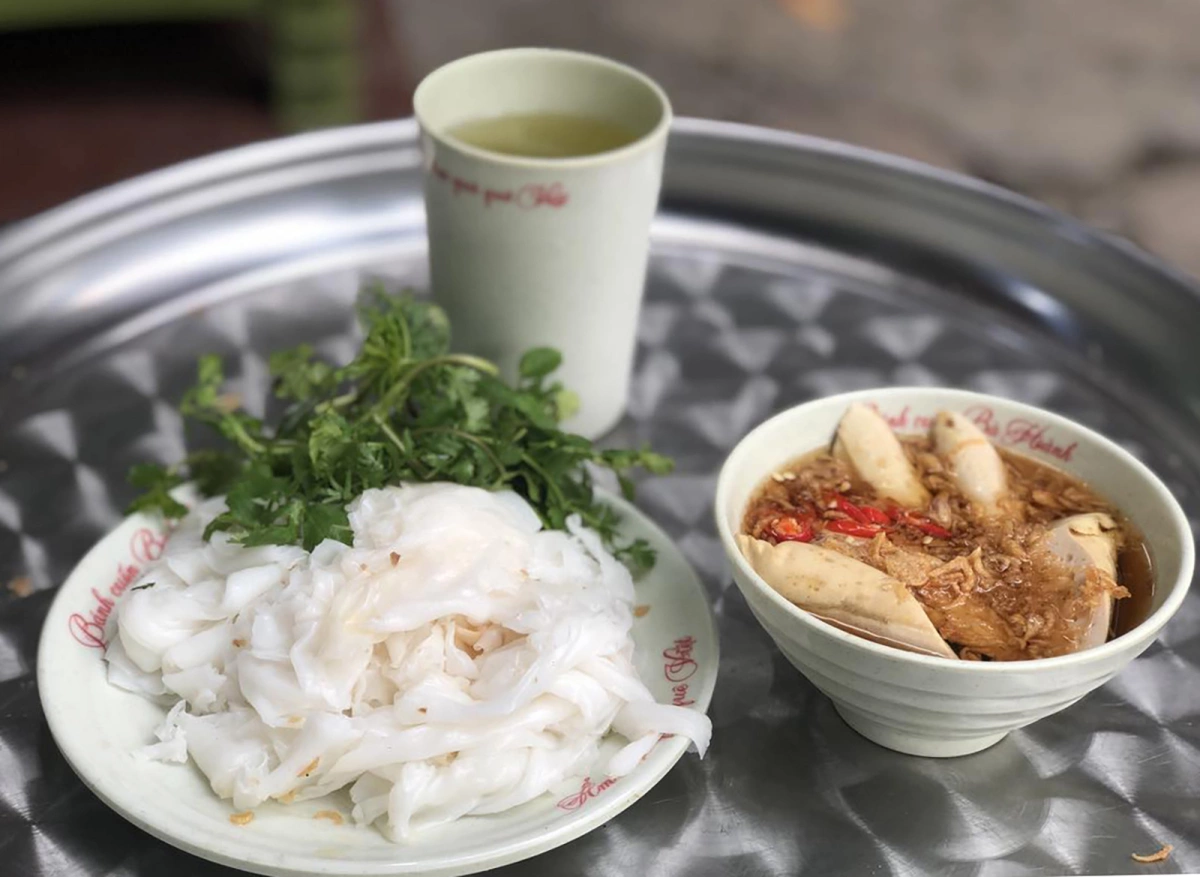Chicken pho
While the origin of beef pho remains a point of debate between Hanoi and nearby Nam Dinh City, chicken pho is considered a hallmark of Hanoi cuisine. The broth is simmered from chicken bones, heads, and feet, sometimes with the addition of pork bones, combined with ginger.
The best chicken for this dish is typically free-range, weighing no more than two kilograms. The chicken skin is golden, the meat has a deep pink hue, and there is no fat under the skin.
Recommended spots:
- Pho Ga Cham: 64-68 Yen Ninh Street, Ba Dinh District
- Do Gia: 9 Nguyen Dinh Thi Street, Tay Ho District
- Bao Khanh: 20 Bao Khanh Street, Hoan Kiem District
- Nguyet: 5b Phu Doan Street, Hoan Kiem District
- Ban: 172 Ton Duc Thang Street, Dong Da District
Photo by Hong Lien
Vermicelli with fried tofu and fermented shrimp paste
A simple yet iconic dish, bun dau mam tom combines fried tofu, vermicelli noodles, and a bowl of fermented shrimp paste that sets it apart. Often served with extras like boiled pork leg, fried spring rolls, blood pudding, and herbs, this dish is a favorite among locals and tourists alike.
Recommended spots:
- 49 Phat Loc Alley, Hoan Kiem District
- Co Tuyen: 31 Hang Khay Street, Hoan Kiem District
- 235b Thuy Khue Street, Tay Ho District
- Cay Bang: 129 Dai La Street, Hai Ba Trung District
Photo by NickM
Thanh Tri steamed rice rolls
In Thanh Tri Ward, nearly 50 households still maintain the traditional craft of making steamed rice rolls by hand. These rolls are made with rice, fat or scallion oil, and shallots.
The rolls come in two types: plain rice rolls (thin rice sheets brushed with scallion oil) and rolls filled with minced pork, wood ear mushrooms, and shallots. They are typically served with pork rolls, cilantro, fried shallots, and a dipping sauce that balances sour, spicy, salty, and sweet flavors.
Recommended spots:
- Banh cuon ba Hoanh: 66 To Hien Thanh Street, Hai Ba Trung District
- Banh cuon ba Hanh: 16B Tho Xuong Street, Hoan Kiem District
- Banh cuon Ba Xuan: 16 Hoe Nhai Slope, Ba Dinh District
- Banh cuon co Lan: 30 Thanh Dam Street, Hoang Mai District
Photo by Hong Lien
Cha ca La Vong - Tumeric fish with dill
Dating back to the late 19th century from a family in the Old Quarter, turmeric fish with dill has become one of Hanoi's most iconic dishes, even featured by CNN as a must-try when visiting the city.
It is typically made from hemibagrus fish, known for its sweet flavor and few bones. The fish is filleted, marinated with spices, and given its turmeric-yellow color. It is first lightly fried, then cooked again in a hot pan with dill and scallions when ordered. The dish is served with vermicelli noodles, fermented shrimp paste, and roasted peanuts.
Recommended spots:
- Cha Ca La Vong: 14 Cha Ca Street, Hoan Kiem District
- Phan: 14 Nguyen Binh Khiem Street, Hai Ba Trung District
- Anh Vu: 103 Trung Hoa Street, Cau Giay District
- Hang Son: 15 Tran Hung Dao Street, Hoan Kiem District
Photo by Hong Lien
Bun thang - Chicken noodle soup with different kinds of strips
Originating as a post-Tet creation to use leftover ingredients, bun thang has evolved into a symbol of Hanoi cuisine. This dish requires preparation, featuring sliced omelet, shredded chicken, sliced pork rolls, and herbs, all served in a clear broth. The broth is simmered from chicken bones, dried squid, and onions.
The dish is complete with shrimp paste, shrimp floss, and a bit of pickled radish. The most distinctive feature of bun thang is the addition of the essential oil from a rare water bug called ca cuong, which adds a fragrant aroma.
Recommended spots:
- Ba Am: 37 Cua Nam Street, Hoan Kiem District
- Pho Cu: 31A Phan Dinh Phung Street, Ba Dinh District
- Thanh Van: 14 Hang Ga Street, Hoan Kiem District
- Ba Duc: 48 Cau Go Street, Hoan Kiem District
Photo by TienHN
Shrimp cakes
West Lake's shrimp cakes are often associated with memories of many locals. Many people who have been away from Hanoi for a long time or tourists often recall the shrimp cake stalls along Truc Bach Lake that have existed for decades.
Made from shrimp and wheat flour, shrimp cakes have a crispy exterior and a soft interior, served with sweet and sour fish sauce and herbs.
Recommended spots:
- West Lake Shrimp Cakes: 1 Thanh Nien Street, Tay Ho District
- Food stalls near Tay Ho Pagoda in Tay Ho District
Photo by Hong Lien
Bun cha - Grilled pork with vermicelli noodles
Hanoi's bun cha was once named one of the top 10 street foods in the world by National Geographic. The most crucial part of this dish is grilling the meat. Hanoi restaurants often use charcoal stoves. The griller must pay close attention, flipping the meat constantly to prevent it from burning, while adjusting the fire to ensure it is evenly cooked. This dish typically includes both grilled pork slices and minced pork patties.
The dipping sauce is a blend of fish sauce, vinegar, sugar, and water, offering a sweet and sour taste. The sauce also contains pickled carrots and green papaya. Diners can add minced garlic and chili to taste. Aside from noodles, the dish is served with herbs like lettuce, perilla, and bean sprouts.
Recommended spots:
- Bun cha Dac Kim: 1 Hang Manh Street, Hoan Kiem District
- Bun cha stalls on Ngoc Khanh Street
- Bun cha Huong Lien: 24 Le Van Huu Street, Hai Ba Trung District
- Bun cha Tuyet: 34 Hang Than Street, Ba Dinh District
- 38 Mai Hac De Street, Hai Ba Trung District
Photo by Xuan Phuong
Xoi xeo - Sticky rice with mung bean
Xoi xeo is a simple yet flavorful dish made from sticky rice, mung beans, fried shallots, and pork fat. The mung beans are soaked overnight, then steamed, pounded, and formed into round blocks. When ordered, the vendor slices the mung beans thinly over the sticky rice. Fried shallots are sprinkled on top, with a touch of pork fat.
Recommended spots:
- Xoi May: 31 Ly Thuong Kiet Street, Hoan Kiem District
- Xoi Yen: 35b Nguyen Huu Huan Street, Hoan Kiem District
- Miss Tuyet's stall: Cu Loc Alley, Thanh Xuan District
- Xoi Oanh Oanh: 573 La Thanh Street, Ba Dinh District
- Xoi Cat Lam: 24b Duong Thanh Street, Hoan Kiem District
Photo by Tam Anh
Bun oc - Snail vermicelli
Bun oc originally consisted of just noodles and snails, without the many additions like tofu, pork rolls, or beef that are common today. The broth is clear and slightly tangy, made from snail-boiling water mixed with vinegar and tomatoes. Snails come in both large and small varieties.
In addition to the hot version, Hanoi locals also enjoy cold snail vermicelli, where the snails are dipped in a sauce. The dish is served with herbs, and diners can add shrimp paste for extra flavor.
Recommended spots:
- Bun oc Miss Hue: 26 Dang Dung Street, Ba Dinh District
- Bun oc Miss Them: 6 Hang Chai Street, Hoan Kiem District
- Bun oc ba ngoai 11 To Ngoc Van Street, Tay Ho District
- Bun oc Miss Hue: 43 Nguyen Sieu Street, Hoan Kiem District
- 19 Kim Ma Thuong Street, Ba Dinh District
- Oc Thuy: 11 Dong Xuan Market Alley, Hoan Kiem District
- Snail vermicelli stalls at Tay Ho Pagoda in Tay Ho District
Photo by Tam Anh
Other popular Hanoi snacks include boiled snails, com (young green rice), and ripe dracontomelon.
Boiled snails
Hanoi snails are named to differentiate from other types of snail dishes across the country. The snails are served hot and are eaten by extracting the meat and dipping it in a fish sauce mixed with lime leaves, lemongrass, ginger, and chili. Many diners enjoy sipping a bowl of snail broth alongside.
This is a street food often enjoyed on sidewalks or in small alleyway eateries, perfect for autumn or winter.
Recommended spots:
- Oc Ba Cam: 5 Tong Duy Tan, Hoan Kiem District
- Oc Trang: 1A Dinh Liet Street, Hoan Kiem District
- Oc Muoi: 22 Lieu Giai Street, Ba Dinh District
Photo by Hong Lien
Com - Young green rice
Com is made from young sticky rice that's roasted, sifted to remove husks and impurities, and then pounded several times until clean and fully peeled.
While com can be found in a few places across the country, Hanoi is most famous for it. It is often eaten with ripe bananas. In addition to plain com, Hanoi locals also enjoy sautéed com, com cakes, and fried patties made with young rice.
Recommended spots:
- Lang Vong: 111 Xuan Thuy Street, Cau Giay District
- Street vendors in Ly Quoc Su Street, Hoan Kiem District
Photo by Vu Minh Quan
Ripe dracontomelon
Ripe dracontomelon is only available in autumn and is a popular snack among generations of Hanoians. The yellow-skinned fruit has a mild sweet and sour taste. What makes this special is its association with Hanoi's most beautiful season and the nostalgic memories it evokes for many.
Ripe dracontomelon is peeled and dipped in salt or mashed with salt and chili, creating a tangy snack that leaves a lasting impression.
Ripe dracontomelon is usually sold on streets like Tran Hung Dao, Hai Ba Trung, Ba Trieu, Tran Phu, around Hoan Kiem Lake, or at snack stalls on Ly Quoc Su Street near the Cathedral.
Photo by Vu Minh Quan

















